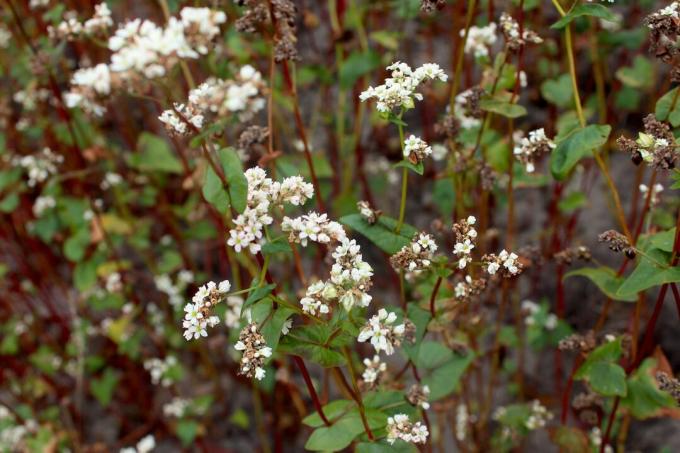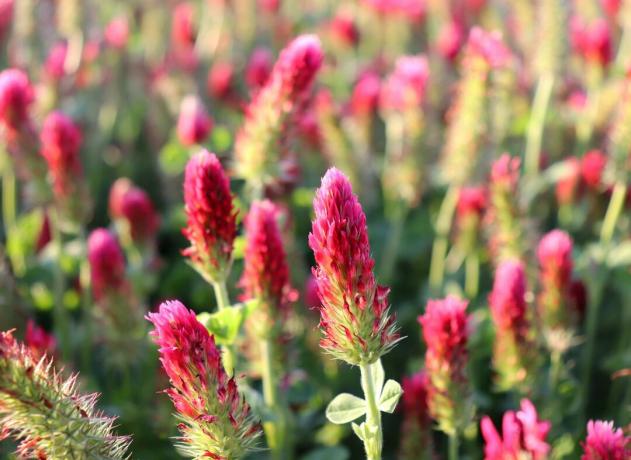Planting green manure in autumn prepares the soil for the next growing season. We show how green manure works in autumn.

You've probably noticed how long winter can be many times, especially when you're longing for it wait to finally bring your young vegetable and annual ornamental plants back into the garden in spring can. But your garden doesn't have to be empty during this time. It would make much more sense to use winter to improve soil fertility. For this purpose, planting soil-improving plants in autumn is considered Green manure a wonderful thing.
contents
-
Green manure in autumn
- What are the advantages of green manuring in autumn?
-
Which green manure is suitable for autumn?
- Freezing off plants as green manure for autumn
- Hardy plants as green manure for autumn
- When do you plant green manure in autumn?
- Green manure in autumn: instructions for planting
Green manure in autumn
While the vegetable garden is in full splendor in summer with juicy tomatoes, aromatic cucumbers and crisp Swiss chard, it is often deserted after the harvest in autumn. Many gardeners then dig up the soil so that they can plant fresh again in the spring. But that has many disadvantages. Nutrients that are otherwise absorbed by plants are washed out and irretrievably disappear from the garden soil. Soil organisms such as earthworms, microorganisms and mycorrhizal fungi, which are irreplaceable for soil fertility, lose their nutritional basis and die. In addition, the valuable garden soil is exposed to the sun, wind, rain and frost without protection. Green manure with soil-improving plants can help.
What are the advantages of green manuring in autumn?
In autumn, when the soil often remains unused anyway, green manure is the ideal opportunity to improve it in a natural way. This offers numerous advantages.

Advantages of green manuring in autumn:
- Soil organisms have a constant nutritional basis through dead plant residues and excretions from the plants, so that the soil activity is promoted.
- The plants used as green manure absorb excess nutrients and especially nitrogen and thus prevent leaching over the autumn and winter.
- The soil is protected from sun, wind, rain and frost.
- The build-up of humus is promoted as the plants bring a large amount of biomass into the soil.
- By choosing the right plants, you can improve the soil without doing a lot. Some plants like legumes fix nitrogen from the air with the help of bacteria, while other plants like buckwheat (Fagopyrum esculentum) Prevent pests and diseases next spring. Still others root the soil in deeper layers so that it is loosened. An example of such a species is the deep radish (Raphanus sativus), which lives up to its name.
Which green manure is suitable for autumn?
Numerous different plant families and species are suitable as green manure. However, crop rotations must also be observed when growing green manure in order to minimize the risk of pest infestation. Due to crop rotation, specialized pests are not fed all year round, but starve to death if their food crops are not available for a long period of time. So do not plant plants from the same family - as the previous or the following vegetable - as green manure. According to cabbage family (Brassica) For example, you should go for deep radish (Raphanus sativus) as green manure.

So crop rotation plays an important role in choosing the right green manure. In autumn it is also decisive whether the plants selected as green manure will freeze over the winter. This has the advantage that you just have to mulch the plants in spring and do not have to worry about removing the green manure. On the other hand, they don't grow like this over the entire winter. So actually a mixture of hardy and freezing off plants is optimal. This has the advantage that you can use the full range of abilities of the freezing plants and the soil is still protected until spring.
Freezing off plants as green manure for autumn
- Real buckwheat (Fagopyrum esculentum): The plant from the knotweed family (Polygonaceae) protects nitrogen from leaching and helps against harmful nematode species in the soil.
- Rough oats (Avena strigosa): This plant from the sweet grass family (Poaceae) contributes to soil health and captures excess nitrogen. The representative of the cruciferous family (Brassicaceae) is often used in agriculture. Its thick and deep roots loosen the soil and thus improve the circulation of water and air in the soil.
- Common flax (Linum usitatissimum): The old cultivated plant belongs to the linseed family (Linaceae). The crop rotation should not be a problem here, because no vegetables belong to this plant family. Common flax has deep roots and is a good partner for mycorrhizal fungi in the absence of garden plants.
- Summer vetch (Vicia sativa): Like all sweet peas, the summer vetch also belongs to the Butterflies (Fabaceae) and fixes nitrogen from the air with the help of nodule bacteria (rhizobia). So your soil is fertilized naturally.

Hardy plants as green manure for autumn
- Winter vetch (Vicia villosa): As a legume (Fabaceae) this hardy plant belongs to the nitrogen fixers. Bacteria, with which the plants live in symbiosis, are always adequately supplied with it. The important nutrient reaches the soil through dead leaves and roots, where it accumulates over time. The winter vetch is an important soil improver.
- Crimson Clover (Trifolium incarnatum): This deep red blooming clover also belongs to the family of the butterflies (Fabaceae) and is able to fix nitrogen.
- Red clover (Trifolium pratense): Red clover is also one of the butterflies. In addition to the nitrogen fixation, the enrichment of humus is a plus point of this plant.
- Italian ryegrass (Lollium pratense): Although the plant belongs to the sweet grass family (Poaceae) annual, but it still survives winter. It is particularly impressive because of its good roots in the upper soil layers.
Unfortunately, flowering plants sown in autumn usually do not bloom before winter. It is true that some of the green manure plants also have the potential to be colorful and as Bee pasture, but this only happens when sowing in spring. more on the subject Green manure can be found here.

When do you plant green manure in autumn?
The right time, of course, depends on the plants you have chosen as green manure. After you have harvested your vegetables or the annual plants have withered, you should plant the green manure as soon as possible. The ideal time is between mid-August and mid-September so that the plants can still grow properly before winter.
Green manure in autumn: instructions for planting
It makes most sense to sow green manure plants as a mixture. You can either put these together yourself or even purchase them ready-made. Mixtures have the advantage that the capabilities of different plants can be used and combined. Before sowing, you should chop up any plant residues and work them into the upper soil layer. Before doing this, remove a little of the top layer of soil and slightly loosen the soil underneath. Now you can spread the seeds over a large area. So that the seeds germinate well, you should now sprinkle the previously removed soil over them so that the seeds are lightly covered with soil. In the end, all you have to do is pour the whole thing carefully. It is better to use a very fine nozzle for this so that the freshly sown seeds are not flushed from the bed again.
Anything else on the subject Green manure to know, you can find out here.



